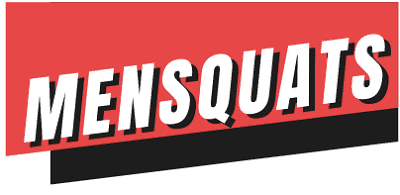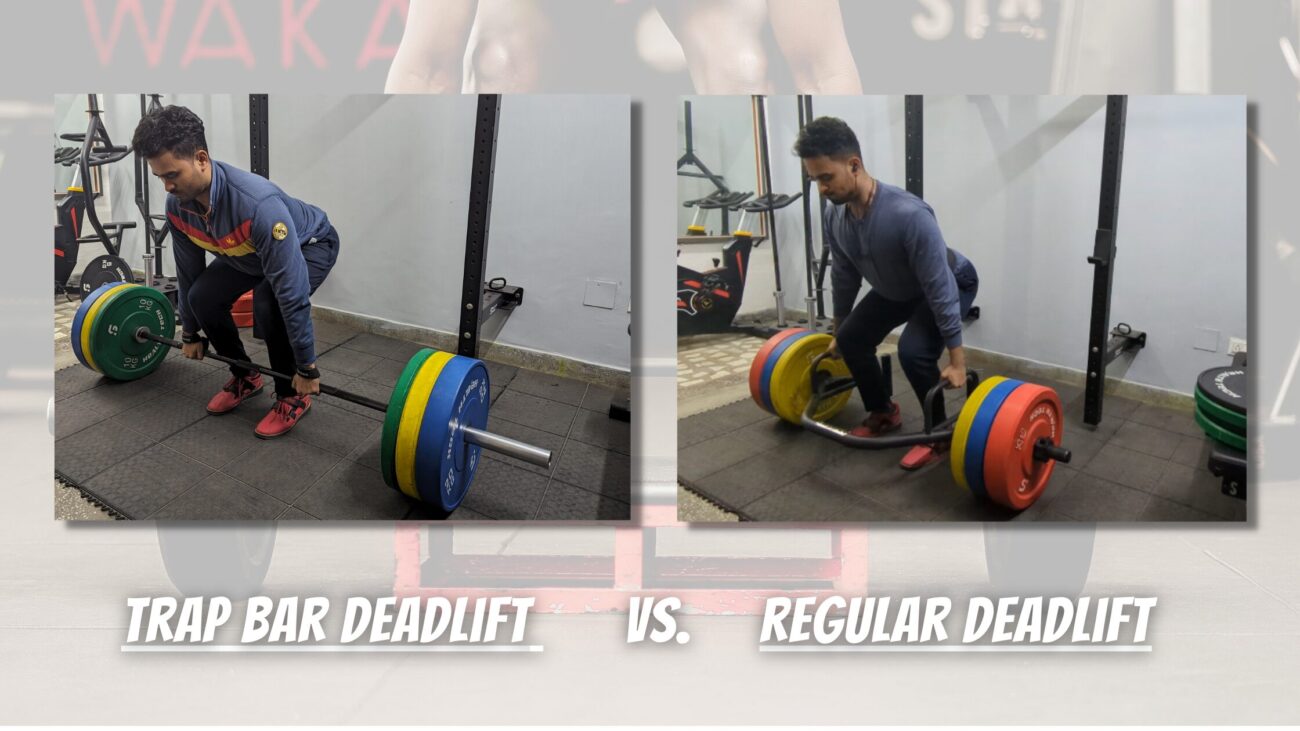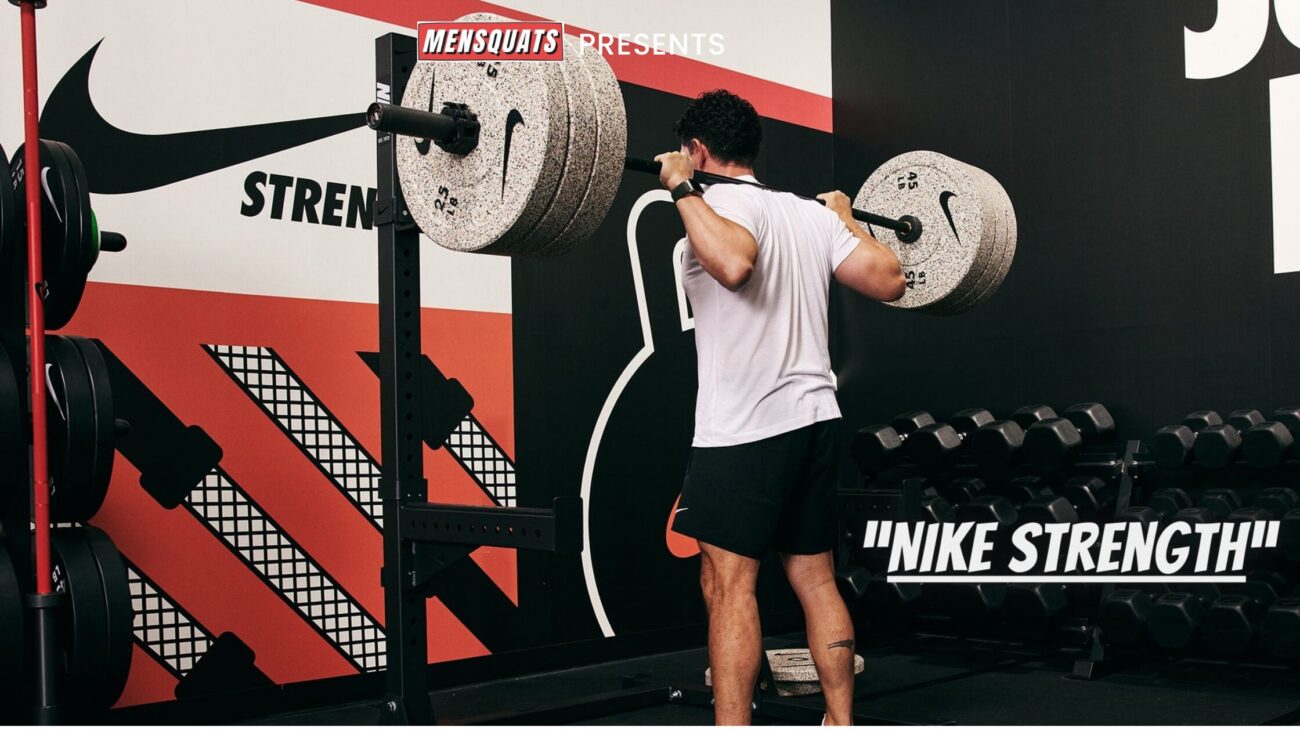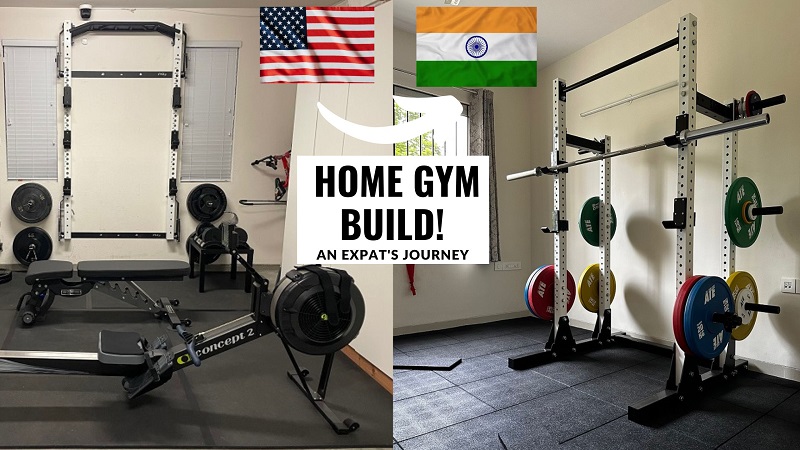3 Best Rubber Flooring For Gym India
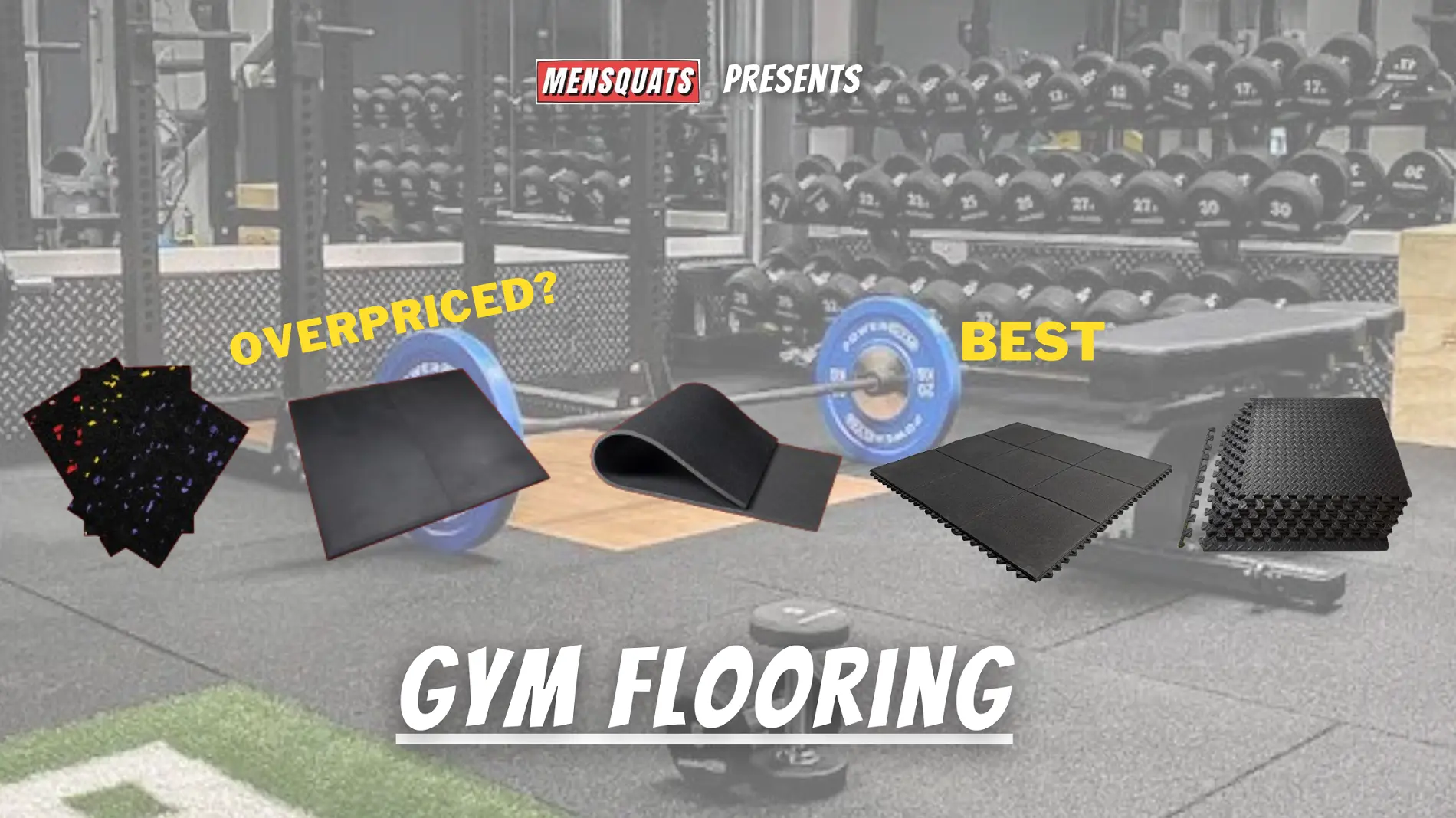
People often ask, what is the best rubber flooring for gym India? what is gym mat flooring price? And its true.
Because when it comes to owning a home gym, or really any gym for that matter, flooring is one of the most important thing that you have to consider. 😀
Even if you’re not doing heavy deadlifts or dropping bars from overhead, it’s going to help distribute that force across your foundation, which, of course, is going to help protect it.
It’s going to provide you with a safer surface for your gym equipment, and it’s going to feel better physically through your joints.
Many of you have asked about the “best rubber flooring for gym India” options.
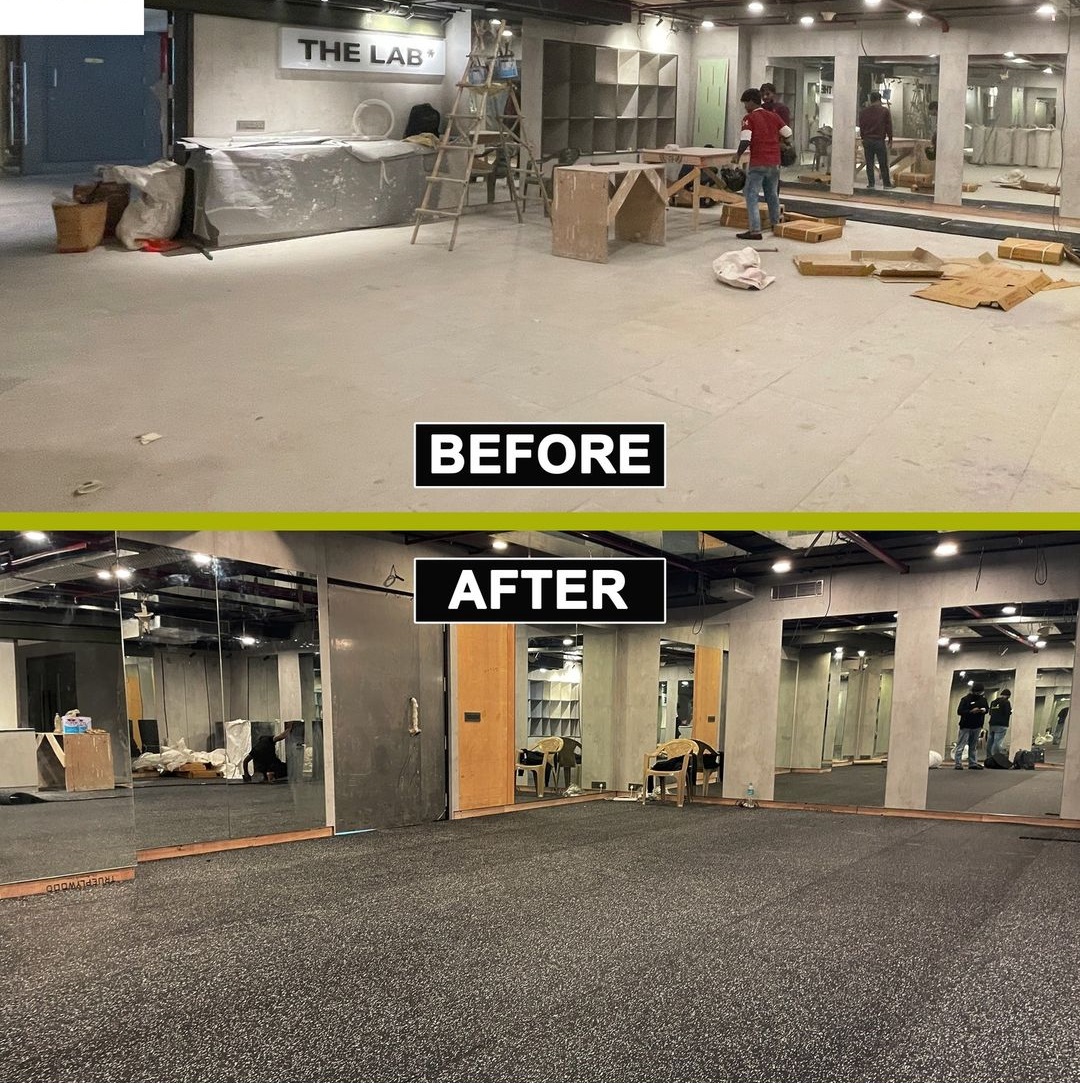
So let’s dive in.👆
How to choose gym flooring?
Flooring can range anywhere from cheap rubber tiles from Amazon, which I don’t typically recommend.
Sure, they might be super comfortable and cheap, perfect for your 2-year-old’s playroom, but they’re terrible for lifting. Next up to cow stall mats, and then even above that, are proper rubber rolls.
This is unquestionably the best type of rubber flooring, but it also can cost you thousands and thousands of rupees. 💲
The first thing to consider is the surface you’re working with. Is it concrete, hardwood, carpet, tile, or something else?
✅ Let’s break it down one by one.
If you’ve a CARPET:

If you’re dealing with carpet, your best bet is modular tiles.
These tiles work great over carpet because they’re made of PVC, offering a balance between foam and rubber in terms of hardness.
They sit well on the carpet, thanks to their unique structure that stays flat.
The interlocking design ensures that each tile stays in place. Installation is straightforward, even on non-flat surfaces.😀
🚀 If you’ve a CONCRETE:
Now, for concrete surfaces, you have more options. The choice depends on your activities.
If you’re into aerobics, our high-density interlocking foam tiles are ideal. You can also place light exercise equipment on them without damaging the foam.
For heavier workouts with weights and equipment, rubber flooring is your go-to.
4×10 foot quarter-inch thick black rubber rolls are economical and practical. Interlocking rubber tiles, available in 3/8 inch thickness, suit most gyms.
You can drop up to 35 kg on these tiles without issues.
👆 Many assume they need thicker rubber, like 0.5-inch or 3/4-inch, but unless you’re dropping extremely heavy weights, it’s unnecessary. Even for heavy weights, our 2-by-2 interlocking tiles in 3/4 inch thickness are sufficient.
However, keep in mind the logistics and costs of transportation, especially for larger sizes like 4×6 feet.
Freight expenses 🚌 can significantly impact your overall budget, especially for residential deliveries requiring a liftgate.
👉 So, when planning your home gym flooring, consider the surface, your workout activities, and the practicality of transportation to ensure you make the right choice without overspending on unnecessary thicknesses. 🔥
3 Best Rubber Flooring For Gym India
✅ There are 3 main types of flooring for home gyms: rubber, EVA foam, and carpet turf.
1. Rubber Flooring For Gym

- Durable rubber construction withstands heavy foot traffic and equipment use.
- Shock-absorbent properties reduce impact on joints and muscles during workouts.
- Slip-resistant surface provides excellent traction, enhancing safety during exercises.
- Gym floor mats price: Typically costs between 200 INR to 500 INR per square foot
Rubber flooring is one of the most popular home and commercial gym flooring options. It’s an easy way to protect subfloors and take your gym to the next level.
We suggest three types of rubber flooring are available in – rolls, tiles, and mats.
1. Rubber Rolls:
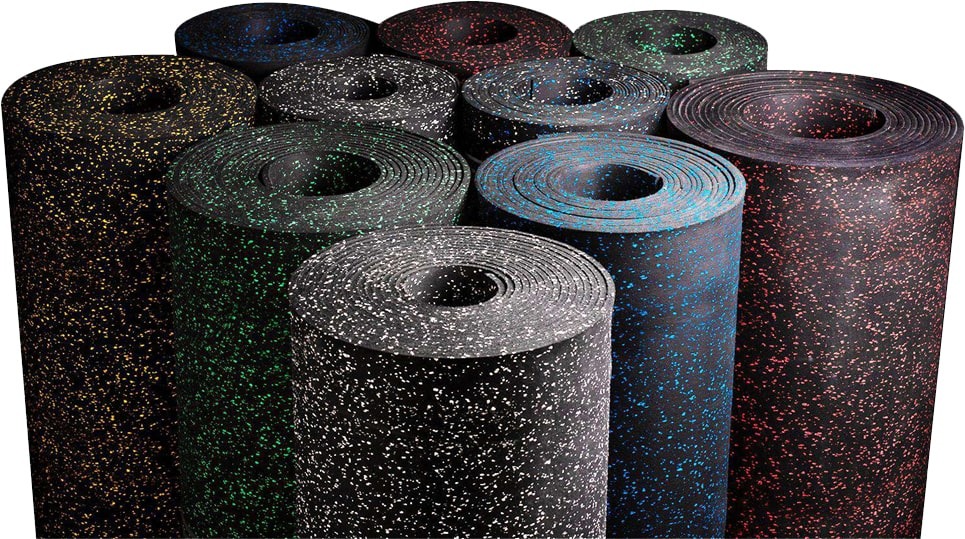
Perfect for covering large spaces, rubber rolls are easy to install by rolling out. Simply cut any excess with a sharp knife to fit your room.
Available in several thicknesses from 1/8″ to 1/2″, catering to various workout intensities.
2. Rubber Tiles:
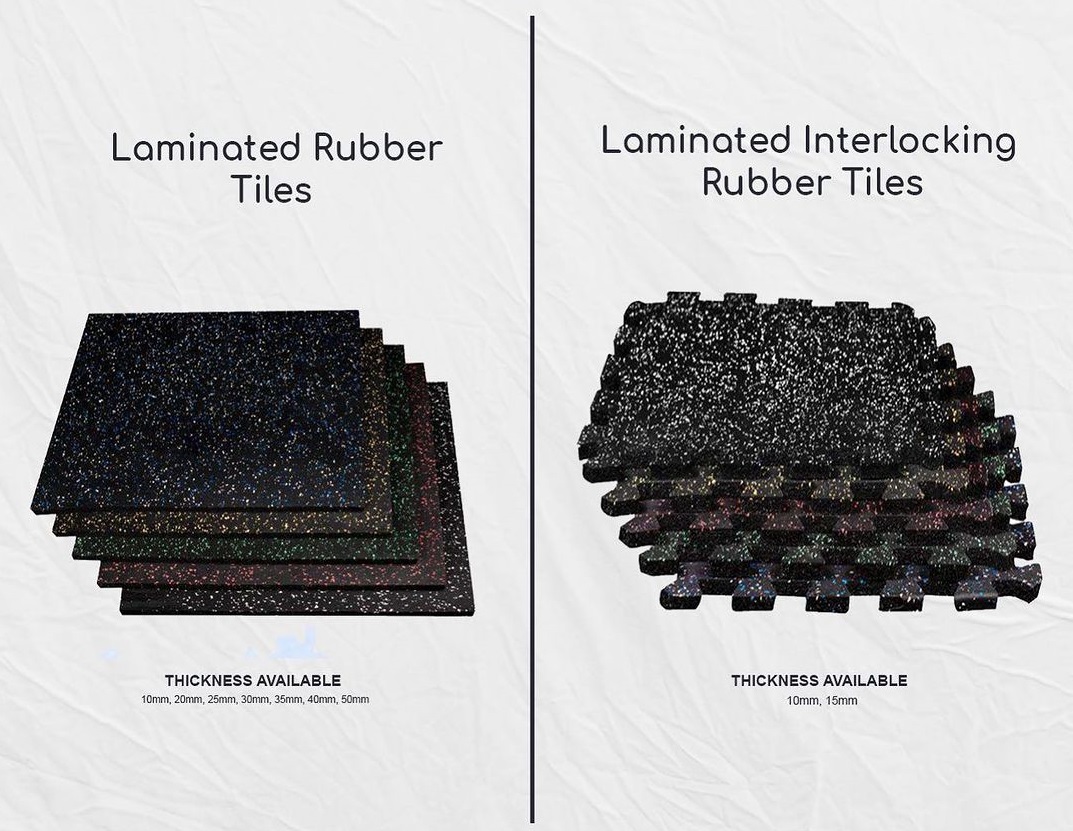
Extremely popular for home gyms, small spaces, or oddly shaped rooms, rubber tiles lock together like puzzle pieces to cover a room or space.
They come in several thicknesses, from 1/4″ to 1″, allowing you to pick the thickness for your fitness goals.
3. Rubber Mats:
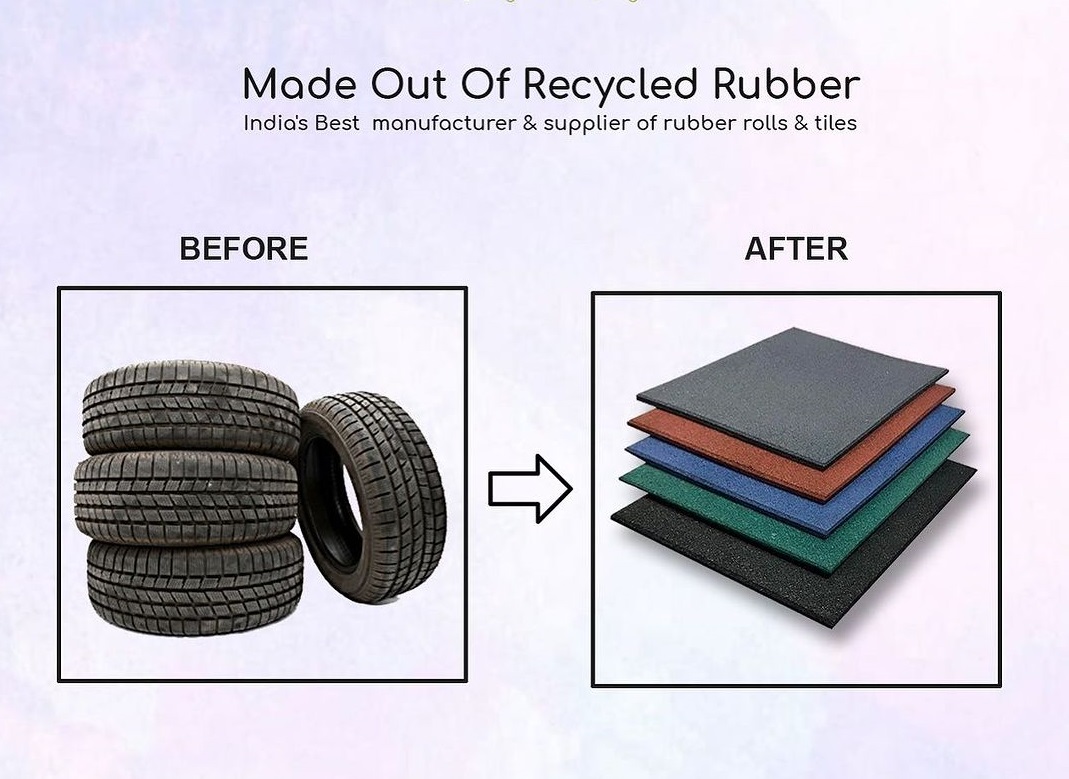
Great for absorbing shock and providing a comfortable place for floor exercises. Rubber mats vary in thickness.
Thinner mats are suitable for stretching and exercise routines, while thicker mats can handle the weight plates of an Olympic lifter.
👆 Rubber flooring offers several benefits.
- It’s sustainable, especially recycled rubber made from old tires.
- It’s excellent for sound deadening, making it ideal for multi-level buildings.
- Its ergonomic properties provide comfort and reduce fatigue, making it popular in fitness centres and healthcare facilities.
Features: Rubber mats come in thicknesses ranging from 1/4″ to 3/4″ – they can handle it all.
✅ Rubber flooring offers numerous great features.
- Suitable for both indoors and outdoors.
- It’s mold, mildew, and slip-resistant.
- Rubber flooring is easy to install, clean, and maintain.
2. EVA flooring For Gym
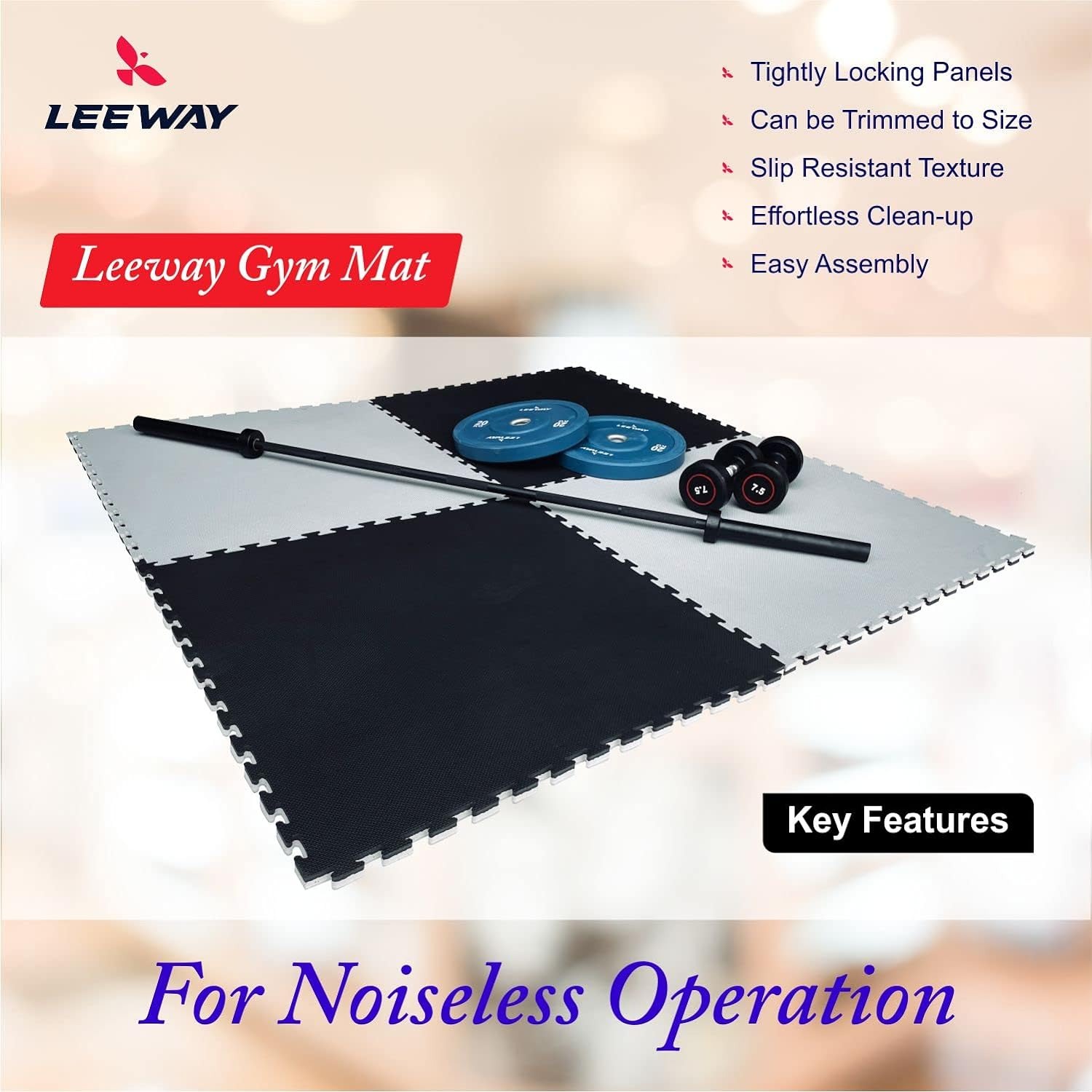
- Lightweight and easy to install.
- Shock-absorbing EVA material reduces strain on joints.
- Versatile designs and colours.
- Gym mat flooring price: Typically ranges from 100 INR to 300 INR per square foot.
👉 EVA foam flooring, made from ethylene-vinyl acetate, is a popular choice for homes. Unlike hard flooring like tile or concrete, EVA foam provides a cushioned surface that’s gentle on your joints and absorbs impact, making it ideal for:
- Home gyms: Protect your knees and elbows during exercise with a soft, shock-absorbing layer.
- Playrooms: Create a safe and playful space for kids to tumble and jump without worry.
Types of EVA foam –
1. Interlocking Tiles:
They’re easy to install and remove, making them ideal for temporary gyms or renters.
2. Rolls:
EVA rolls are perfect for covering large areas. They require more effort to install than tiles but provide a smooth, uninterrupted surface.
3. Puzzle Mats:
Designed for children’s play areas, these interlocking mats come in fun shapes and colours.
Thickness Matters:
- Thin tiles (6mm – 8mm): Ideal for low-impact activities like yoga or light exercise. They’re also easy to clean and store.
- Medium tiles (10mm – 15mm): Offer increased cushioning for moderate-impact activities like bodyweight exercises and playtime.
- Thick tiles (20mm – 25mm): Provide maximum shock absorption for high-impact activities like weightlifting and jumping. They’re also great for protecting floors. 🔥
✅ Both EVA foam and rubber flooring offer comfort and protection, but they have their own pros and cons:
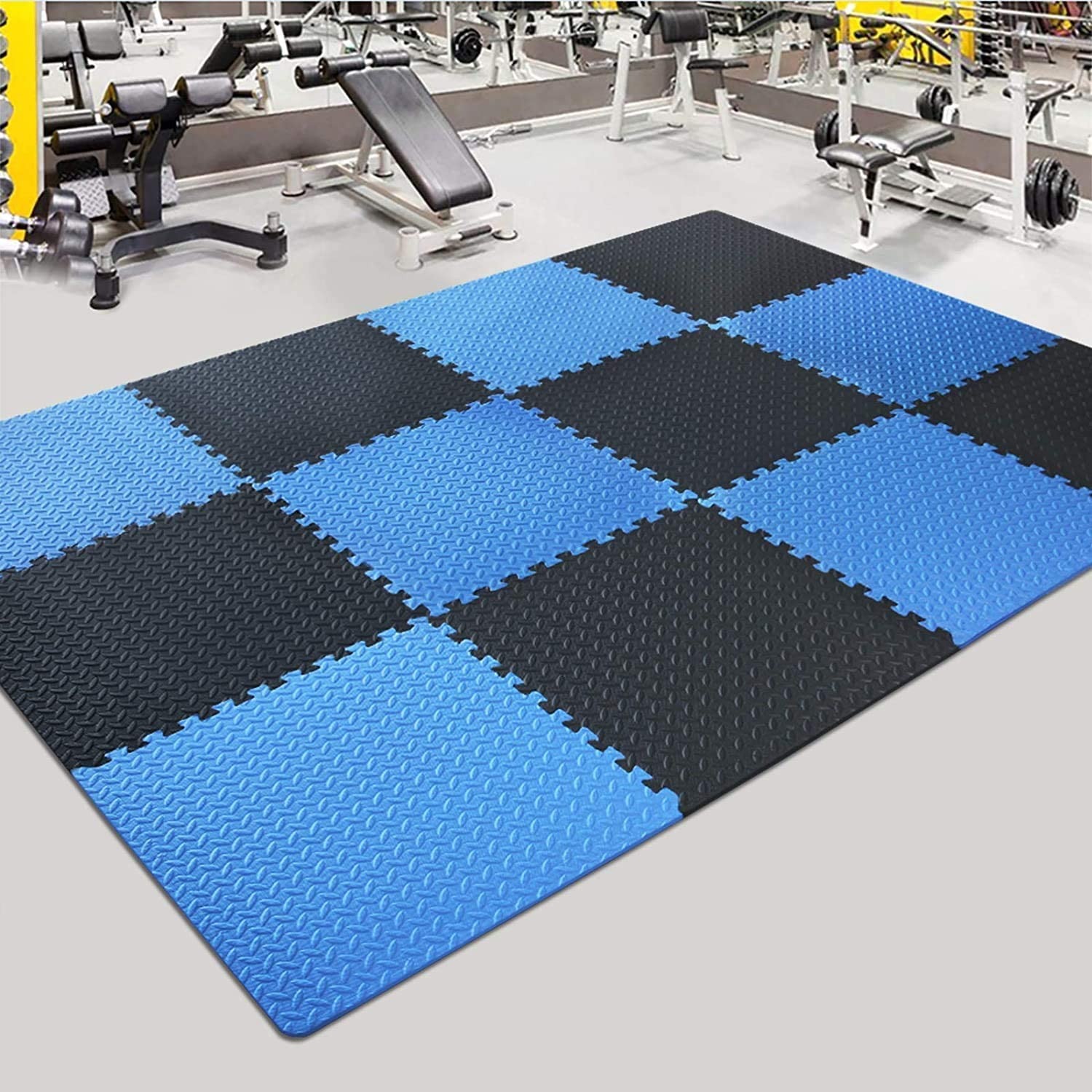
EVA Foam:
Pros
- More affordable, lightweight, quieter underfoot, warmer to the touch, more colour and pattern options.
Cons
- Less durable than rubber, can tear or puncture, not as water-resistant, may not provide enough support for heavy weights.
While EVA foam is cheaper, I strongly recommend rubber flooring for its durability and grip.
Bonus Tip: If you‘re buying EVA foam tiles, look for flooring made from non-toxic materials, especially if you have young children or pets at home.
3. Vinyl Flooring For Gym

- Water Resistance: Resistant to moisture, making it easy to clean and maintain.
- Vinyl flooring is made of PVC, whereas rubber flooring is made of natural rubber compounds.
- Affordable Pricing: Typically ranges from 150 INR to 400 INR per square foot.
While it might not be the first material that comes to mind, vinyl flooring offers distinct experiences underfoot. It’s like finding the sweet spot between affordability and style, comfort and performance.🔥
Imagine wood-grain patterns or vibrant colours cushioning your steps. However, its lower shock absorption makes it less suitable for intense workouts with heavy weights.🆗
Vinyl Flooring Types:
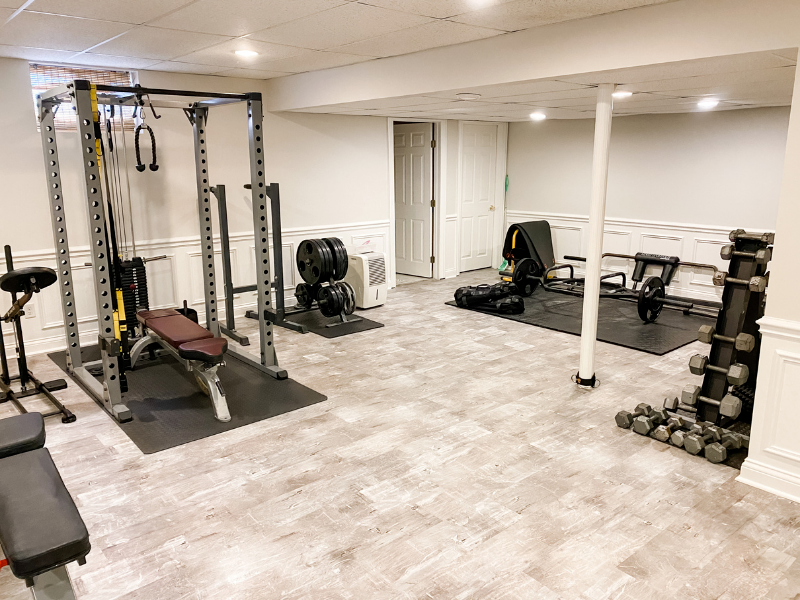
1. Interlocking Tiles:
These are the most popular, offering easy installation and removal thanks to their snap-together design. Perfect for DIY enthusiasts and temporary gyms
2. Sheets:
This classic rolled format provides seamless coverage for larger areas. While installation might require professional help, it creates a smooth, uninterrupted surface.
3. Luxury Vinyl Tiles (LVT):
These thicker tiles are the champions of comfort and performance. They offer superior shock absorption, ideal for high-impact workouts, and are often water-resistant, making them perfect for sweaty sessions.
👉 Finding the Right Thickness:
- Thin sheets (2-3mm): Ideal for low-impact areas like stretching zones or yoga mats. They’re budget-friendly and easy to install, but not as durable or shock-absorbent for intense workouts.
- Standard tiles (4-6mm): A good middle ground for moderate-intensity exercises like bodyweight circuits or cardio machines. They offer reasonable comfort and durability while remaining affordable.
- Luxury vinyl tiles (7mm and above): The champions of comfort and performance. These thicker tiles provide excellent shock absorption for high-impact activities like HIIT or weightlifting. They’re also water-resistant, making them suitable for sweaty workouts. However, be prepared for a higher price tag.🏷️
Where Vinyl Shines:
✅ Vinyl flooring’s versatility extends beyond just the gym floor. Here are some areas where it excels:
- Cardio zones: Vinyl’s smooth surface is perfect for treadmills, ellipticals, and other cardio equipment. It’s easy to clean and won’t damage the machines.
- CrossFit areas: Vinyl’s grip and shock absorption make it suitable for a variety of CrossFit exercises, offering a comfortable and functional surface.
- Locker rooms and showers: Water-resistant vinyl is a hygienic choice for these areas.
Pros & Cons:
Pros
- Affordable, easy to install, wide variety of styles and colours, comfortable underfoot, water-resistant.
Cons
- Less durable than rubber, can tear or scratch, not ideal for heavy weights or dropped equipment, some vinyl options contain VOCs.
👉 If affordability and style are your main concerns, vinyl flooring might be the perfect fit.
But if you prioritise durability, performance, and safety for high-impact workouts, rubber is the clear winner.🔥
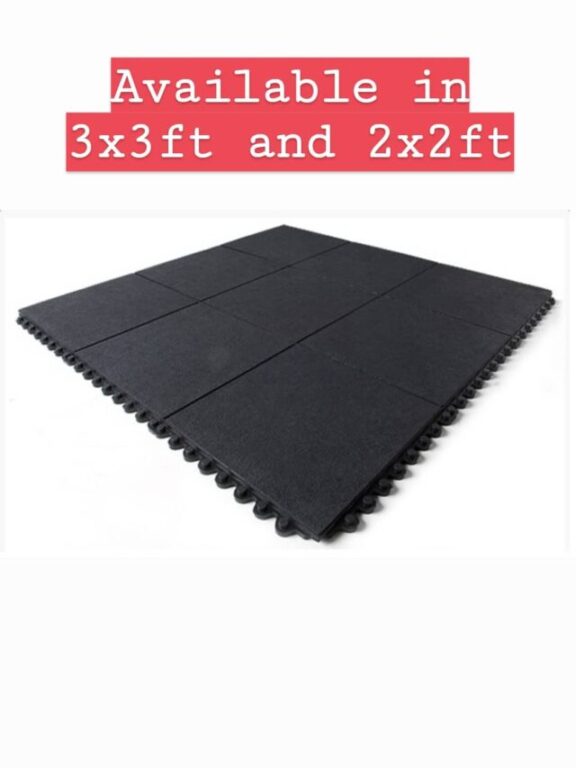
Tips on Buying Gym Flooring!
Tip 1: Buy From Same Store:
Try to buy all of your mats at the same time from the same company.
👉 Fab Flooring in India is the most common store that you can find these at, although there are other stores that you can look into as well.
This is purely an aesthetic tip, but you greatly increase the chances of your flooring looking more seamless and cohesive if you buy them all at the same store at the same time.
Because odds are, they were generated and produced in the same lot. If you do so, they all will be blended almost perfectly together.
Tip 2: Prevent Movement:
Prevent movement or seams with tape or mending plates.
If you find you have some seams, either because of temperature or because your mats aren’t wall-to-wall tight, then a very popular and effective way to combat that is by taping them from the top. The best product to use for that is Black Tape.
It works perfectly functionally, and aesthetically, it blends in okay. I don’t really care for the look very much personally, but you can put mending plates underneath your mats when you install them.
These basically bridge the mats together; they keep them very tight, and they’re thin enough to where you don’t feel anything weird underneath you!
Tip 3: Reduce Smell
😀 Let your rubber mats off-gas or use an odour eliminator. The biggest downside to a stall mat is that it can emit a very intense rubber smell.
Some people find this to be totally overwhelming, and while that smell does tend to dissipate some over time, there are a couple of steps that you can take to help speed that process up or otherwise improve it.
One way is to just take them outside, and let them sit out in the sun. Let them individually off-gas and get some vitamin D.
The other option is to use an odour eliminator or a deodorizer.
👉 I’ll put a link, but you just thoroughly apply those to your mats, and according to some people, it does a really good job of helping reduce some of that smell.
Tip 4: Clean
Clean your stall mats with Simple Green or a dedicated rubber cleaner.
You can either buy the spray version or if you have a larger area, you can buy the bigger bottle, the fully concentrated bottle, and then just cut it with some water.
For really stuck-on dirt and grime, I’d recommend picking up one of these deck brushes. You can get them for less than Rs 100, and they last forever.
Tip 5: Cold Weather:
For optimal results, consider purchasing your mats during the colder months.🥶
Picture them akin to living beings in chilly weather, much like some men might relate to—they tend to contract slightly. When temperatures rise, especially with added humidity, they tend to swell and expand.
👉 Buying mats during colder months is advisable because they’re already contracted. When you lay them out and secure them tightly, you effectively set the seams.
Even in hot, humid conditions, they won’t buckle due to their weight and the equipment atop them.
Conclusion
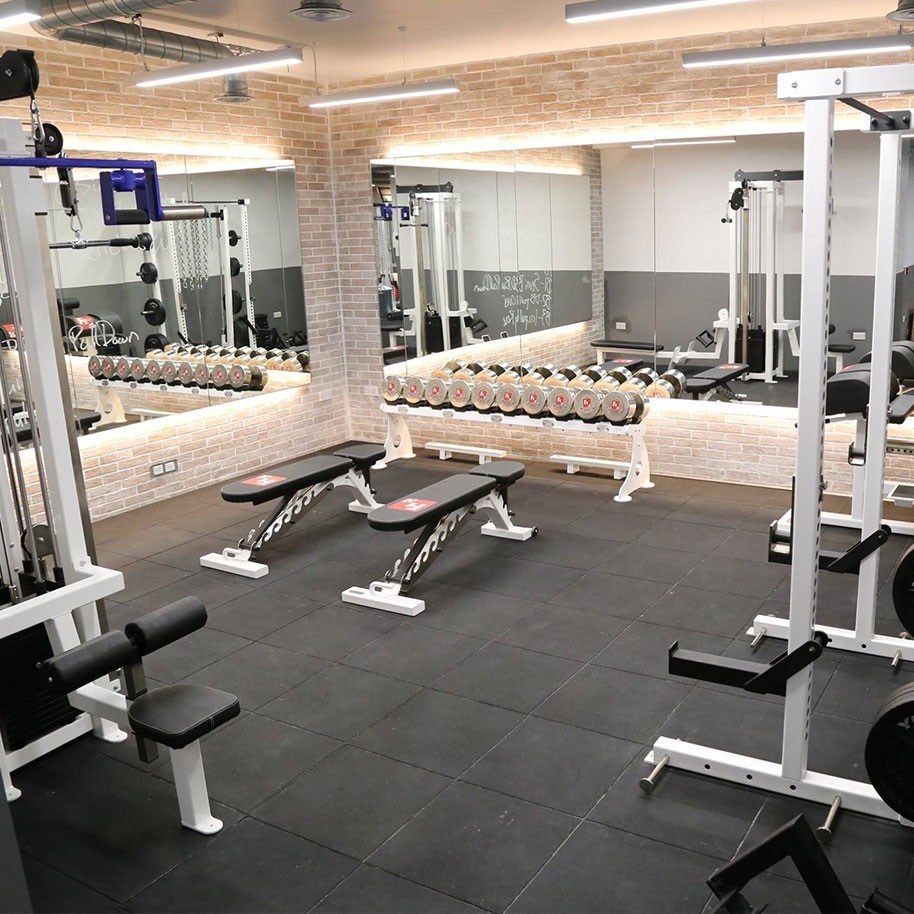
✅ Within rubber flooring, you have tiles and rolls options.
For most people, I recommend rubber rolls flooring. They’re durable, give a sleeker look, catch less dust and are easy to find at supply stores. Plus, they’re thick enough to protect your flooring.
However, if you’re doing heavy deadlifts or Olympic lifts, always consider adding a weightlifting platform!
❌ Avoid EVA foam tiles—they’re flimsy, collect dust, and offer poor stability. As for cleaning, I recommend simple green and a deck brush.
To get rid of that rubber smell, let your mats air out outside. And if you’re wondering when to buy rubber mats online, Amazon usually offers the best deals.
Lastly, will rubber rolls damage your foundation? In most cases, no. But use common sense—don’t drop heavy weights from overhead recklessly.
FAQs
Q1. How Thick Should the Rubber Gym Floor Be?
😀 The ideal thickness is:
- Weightlifting & CrossFit gyms: 10mm – 15mm thickness is recommended.
- Low-Impact Exercises (yoga, pilates): 4mm – 8mm thickness is sufficient for these gentler activities, providing a cushion for joints and comfort.
- Multi-Purpose gyms: Use thicker 15 mm+ rubberized sections for weightlifting areas and thinner foam tiles for yoga or stretching spaces.
Q2. How to Clean Rubber Floor Mats in a Gym?
Maintaining clean rubber mats is crucial for hygiene and preventing bacterial growth. Here’s your cleaning routine:
- Regular cleaning: Sweep or mop the mats daily with a diluted solution of dish soap or vinegar. This removes dust, sweat, and light dirt.
- Deep cleaning: For stubborn stains or grime buildup, use a commercial rubber floor cleaner or a homemade paste of baking soda and water. Scrub gently and rinse thoroughly.
- Important tips: Avoid harsh chemicals and abrasives, as they can damage the rubber. Allow the mats to dry completely before use.
Q3. How to Make a Home Gym Floor?
Here are some options:
- Budget-friendly:
- Foam tiles: Easy to install and affordable, offering decent comfort and noise reduction.
- Interlocking flooring planks: Provide a firmer surface and more durability compared to foam tiles.
- Plywood with carpet or rubber mats: A simple and inexpensive option, but less portable and requires regular vacuuming or carpet cleaning.
- Durable:
Rubberized rolls or interlocking tiles: Offer excellent shock absorption, noise reduction, and easy cleaning. Ideal for heavier weights and high-impact workouts.
Q4. How to Build a Home Gym Floor?
The complexity of building your home gym floor depends on your desired setup. Here are two approaches:
- Basic:
- Lay plywood over the subfloor for a smooth and stable base.
- Add carpet or rubber mats for comfort and grip.
- Secure everything with nails or adhesive.
- Advanced:
- Install interlocking rubber tiles for easier assembly and disassembly or rubber rolls.
- Consider a weightlifting platform for heavy lifting zones, like deadlifts.
- Consult DIY guides or flooring professionals for complex setups.
Q5. How to Clean a Rubber Gym Floor?
The cleaning process for a rubber gym floor is similar to cleaning rubber mats:
- Regular cleaning: Use a broom or mop with a diluted dish soap or vinegar solution to remove dust, dirt, and sweat.
- Deep cleaning: For tougher stains or grime, use a commercial rubber floor cleaner or a homemade baking soda paste. Scrub gently and rinse thoroughly.
Important tips: Avoid harsh chemicals and abrasives, as they can damage the rubber. Allow the floor to dry completely before use.
Q6. How to Install Gym Flooring?
Installation options vary depending on the type of flooring you choose:
- Interlocking tiles: The easiest DIY option, simply snap the tiles together.
- Rubber rolls: Require cutting to size and applying adhesive to the subfloor. This might be best left to professionals for large areas or precise cuts.
- Professional installation: Consider hiring flooring experts for complex layouts, large spaces, or if you want a guaranteed perfect installation.
Remember: These are general guidelines, always check specific product recommendations and instructions for your chosen flooring material.
Q7. Is vinyl or rubber flooring better for home gyms?
Rubber flooring wins for durability & impact absorption, perfect for heavy weights & jumps. Vinyl flooring shines in affordability & style, ideal for light workouts & budgets. Choose based on your priorities!
That’s it for “Best Rubber Flooring For Gym India”. 🔥
Stay tuned for more in our series, and feel free to drop your questions in the comments.
Thanks for reading!
